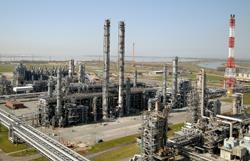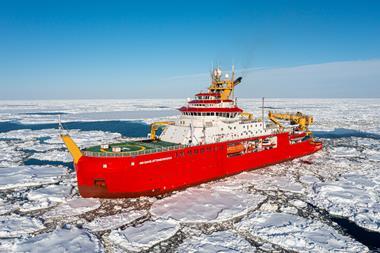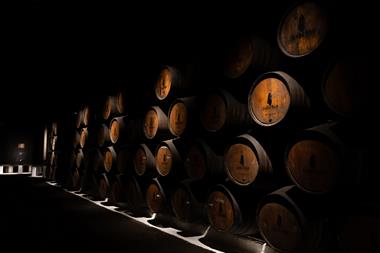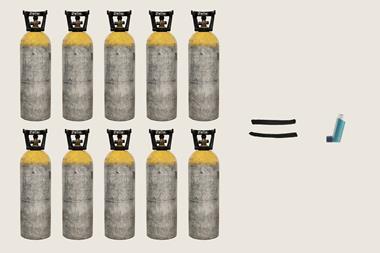Forecasts predict that oil prices will remain high. This could have a major impact on the structure and economics of the petrochemical industry. Sean Milmo reports
Forecasts predict that oil prices will remain high. This could have a major impact on the structure and economics of the petrochemical industry. Sean Milmo reports
Current forecasts about long-term trends in oil prices are raising the prospect of a major shakeup in the global petrochemical industry.
The Bank of England concluded in a study issued in August, when oil prices were well over $60 (?33) a barrel, that trends in the oil futures markets suggest that ’the price of oil will remain around its current level for the next few years’.

Goldman Sachs, the investment bank which is a big trader in the commodity markets, predicted in a report around the same time that US benchmark oil prices would stay above $60 a barrel for at least another five years.
Some energy forecasters believe that because of insufficient supplies there will be further surges in oil prices like that which pushed them from below $30 per barrel to well over $40 in less than two years.
These pundits argue that the world will shortly be entering a period when oil production will peak and then steadily decline putting permanent upward pressure on crude prices.
Amidst all the varying predictions, the most certain scenario is that oil prices will stay above an average of $40 per barrel for a lengthy period, particularly since the emerging economies of Asia, especially China and India, with their huge needs for energy, will continue to expand relatively quickly.
’The oil price is not going to sink back to the levels of one to two years ago,’ says Klaus Kilian, marketing manager at Lurgi, the German-based oil, gas and petrochemical engineering group. ’It may go down to $50 per barrel or even $45 but not much lower than that,’ he adds.
Even an average oil price at or above $40 for several years would be sufficient to have a major impact on the structure of the global petrochemical industry and the position of the sector within the worldwide chemical industry.
Focus on the Middle East
Perhaps the biggest effect will be that petrochemical producers will become even more concentrated in areas close to low-cost oil and gas. Because of their access to cheap feedstocks, petrochemical companies in the Arabian Peninsula and Iran will have an even greater cost advantage over producers elsewhere in the world, particularly in Europe and North America.
Middle East governments will be using some of the monies earned from higher oil prices to build more petrochemical plants. Furthermore, the huge margins enjoyed by petrochemical businesses in Saudi Arabia, the neighbouring Gulf states and Iran are attracting large amounts of private investment funds, some of which previously would have been placed in the capital markets of Europe or North America.
As a result, the Middle East’s ethylene capacity, which since the mid-1990s has increased by seven million tonnes, is forecast to expand by 20 million tonnes or by about 150 per cent to around 32 million tonnes by the early part of the next decade. In the Far East, where much of the global growth in demand for ethylene derivatives will take place, ethylene capacity is predicted to rise by only 40-50 per cent.
By 2012 the Middle East will have nearly the same amount of ethylene capacity as North America and around a fifth more than that in western Europe.
With plentiful supplies of inexpensive and highly profitable ethylene derivatives pouring out of the Middle East, there will be a reluctance to invest in more crackers in North America or western Europe. Hence, in six to seven years capacity in both regions should be only slightly higher than it is today.
’If oil prices average around $40 per barrel, there would be little sense in putting money into new crackers which do not have access to low-cost ethane,’ says one petrochemical analyst. ’If oil prices are to stay at $60 or above, it would be mad to look anywhere else but the Middle East.’
North American and European producers are even hesitating about putting money into debottlenecking expansions because of worries about poor financial returns at a time of pressure on feedstock costs.
Nonetheless shifts in the burden of feedstock costs are beginning to occur between regions outside the Middle East, which could influence investment decisions on capacity increases.
Steep rises in gas prices have considerably weakened the competitiveness of the US petrochemical sector, which could ironically benefit producers in western Europe.
’Of the three major regions of North America, western Europe and Asia, western Europe used to be in the worse position with regard to raw materials costs,’ explains Paul Hodges, chairman of the UK-based consultancy International eChem.
’But the big increase in US gas prices and more expensive feedstocks in Asia are making western Europe’s costs the lowest of the three,’ he adds. ’This means that western European petrochemical sites are better placed to attract the relatively little investment money going into the sector on either side of the Atlantic.’
In fact BASF announced in late August a long-awaited decision to go ahead with a capacity expansion at its naphtha ethylene cracker at Antwerp, Belgium. The increase will raise its capacity from 800 000 tonnes a year to 1.08 million tonnes, making the plant the largest single-train steam cracker in Europe.
However the €200 million (?135 million) expansion will not be carried out until the autumn of 2007 when the next regular turnaround of the facility is due to take place, thus avoiding any additional shutdown. ’We carefully evaluated our internal demand developments and the external market situation for cracker products and came to the conclusion that 2007 is the right time for the expansion,’ says Werner Praetorius, president of BASF’s petrochemical division.
BASF does not expect there will be any other major new cracker projects in Europe until at least 2009, with average demand for ethylene expected to grow by only 1-1.5 per cent a year in the region.
As the Middle East rapidly increases its share of global ethylene capacity there will be a squeeze on supplies of propylene and aromatics because of the region’s reliance on ethane feedstocks.
Propylene and aromatics supplies are already failing to keep pace with buoyant global demand for their major derivatives, such as polypropylene, polycarbonate and polyester.
Already this imbalance is being reflected in the prices for propylene and some aromatics. Propylene prices have risen to the same level as those of ethylene, whereas historically they have tended to be 25-30 per cent lower.
’Propylene and ethylene have never been at the same price before,’ says Philip Leighton, a consultant at Jacobs Consultancy, London, UK. ’Now we will see the propylene price go even higher than ethylene.’
Benzene prices rise
In the aromatics market, the benzene price has been rising steeply. At times it has commanded a premium over the price of naphtha of as much as $500-600 per tonne, although this summer the excess declined to $200-300.
’Previously the price of benzene over naphtha has increased to over $120 per tonne but it soon came back down again so the average premium has been around $70-75 per tonne,’ explains Hodges. ’We believe that the price of benzene will stay high for some time so that it will have an average premium over naphtha of around $175 for five years.’
Benzene has become scarce because high crude oil prices and shortages of refinery capacity have pushed gasoline prices to such a level that it has been more profitable to channel aromatic streams into fuel production. European refineries have in fact been sending shipments of reformates across the Atlantic to the US because of the pressure on gasoline supplies in the country.
’US refineries are paying good money for gasoline components like toluene from Europe,’ says Hodges. ’Toluene, from which benzene is produced, will continue to be transported across the Atlantic until there is a fall in demand for gasoline in the US. Ethylene crackers are a major source of benzene but there are no new crackers planned in Europe, only expansions through debottlenecking.’
’Benzene supplies could be increased through investment in benzene capacity in the refineries. But the oil companies are putting all their money instead into oil and gas exploration and production because the returns are so much higher.’
The main technology for making benzene from toluene is hydro dealkylation (HDA), which provides a yield of as much as 95 per cent. Toluene disproportionation or transalkylation, which converts two molecules of toluene into one molecule each of benzene and xylene, is another source.
’A $75-100 million investment in an HDA plant with a capacity of around 200 000 tonnes a year will give a return on 15-20 per cent over 10 years,’ says Hodges. ’But oil companies can currently earn much bigger returns of 30-40 per cent by putting their money into exploration and production.’
Some benzene derivative producers like Dow Chemical have invested in HDA capacity. But others consider the investment costs too high, even with the prospect of continued high benzene prices.
’Benzene prices will have to remain at a very high level before we could justify such a huge investment as one in an HDA unit,’ says Stefan Marcinowski, executive board member responsible for research at BASF, a leading styrenics producer.
’The scheduled expansion of our cracker at Antwerp will help provide extra supplies,’ he says. ’We also have a new joint-venture cracker on stream at Nanjing, China, but the benzene from that is committed to our partner Sinopec.’
’We also have research projects which are investigating cheaper alternative ways of obtaining benzene, other than through the HDA process,’ he continues.
BASF acknowledges that due to the unpredictability of short-term benzene prices, derivatives such as polystyrene are coming under pressure from other plastics, especially polyolefins.
’Around 75 per cent of the production costs of polystyrene come from the price of benzene which has been extremely erratic compared with the prices of other petrochemical raw materials,’ says Marcinowski. ’In some applications we do see that polystyrene will be replaced by other materials.’
Polypropylene maintains its growth
Despite the extra raw material costs generated by propylene shortages, polypropylene, the main propylene derivative, is still maintaining above average growth as it continues to replace other polymers, especially in packaging. It has remained competitive against aromatic derivatives, such as polystyrene and PET, although sometimes by sacrificing margins.
At a time when retailers and consumer product companies are trying to cut packaging costs, polypropylene is still able to prove itself to be more cost effective than polystyrene in packaging foams. Because polypropylene is stronger than polystyrene, polypropylene foams require as much as 70 per cent less material.
In film applications, polypropylene is replacing PET because not only does it have greater price stability but also higher temperature resistance at a time of growing popularity of microwaveable ready meals.
Polypropylene and polyethylene are also benefiting from the way flexible packaging is expanding its share of the total packaging market because of the need for retailers and brand owners to save costs by using less and lighter packaging.
In the longer term the availability of new technologies seems likely to avert critical shortages of propylene giving it a greater security of raw material supplies than with some aromatics.
ABB Lummus Global has been reporting a big rise in the number of orders for its olefin converting technology (OCT) which is based on the principle of metathesis, enabling propylene to be produced catalytically via the reaction of butenes or C4s and ethylene.
LG Petrochemical of Korea recently purchased the OCT technology to increase its output of propylene by around 120 000 tonnes per year at its Yosu site by processing C4 raffinates from units making methyl tertiary butyl ether and methyl methacrylate.
Lurgi reports growing interest in its technology for making propylene directly from methanol, which has previously only been economical at sites supplied by cheap gas feedstocks. It estimates that at an integrated gas-to-polypropylene complex in the Arabian Gulf with natural gas prices of $0.75 per million British thermal units, its methanol-to-propylene (MTP) process would provide an internal rate of return of 19 per cent.
This estimated return is based on a polypropylene price of $800 per tonne, which is well below the average prices for the polymer over the past one to two years. If polypropylene prices stay at a historically high level while there are continued worries about availability of propylene supplies, the MTP process will become economical at sites outside the Middle East and other areas with cheap gas feedstocks.
’There are now scenarios developing in which it would be viable to ship methanol to some Asian countries where it would then be turned into propylene with the MTP process,’ says Kilian of Lurgi. ’These would be countries where there is not at the moment much refining or ethylene capacity as a source of propylene.’
Soaring oil prices have also caused coal producers to investigate the possibility of using coal gasification as a route to make petrochemicals at a competitive cost, according to Lurgi which has a joint venture in gasification technology with Sasol of South Africa.
’Chinese coal mining companies are considering the feasibility of producing methanol from gasification processes, not only to make propylene but other petrochemicals feedstocks,’ says Kilian. ’Countries like China and India do not have much of their own oil and gas but China, especially, has a lot of coal reserves.’

Competition from renewables
Another emerging source of competition for existing petrochemicals are materials coming from renewable resources, whose long-term prospects have been considerably brightened by huge hikes in oil prices.
In the packaging sector, producers of polylactic acid such as Cargill’s NatureWorks claim that the crop-derived polymer is now competitive in terms of both cost and performance with petroleum-based materials and fibres.
Oleochemicals such as glycerine have this year been as much as €500 per tonne cheaper than competing petrochemical-derived glycols. In September, the price of glycerine had fallen to €450 per tonne, compared with a peak of over €1000 two years ago.
’Glycerine demand is up five per cent since the beginning of the year but it is not clear how much of the increased demand is a result of glycerine replacing petrochemical-based raw materials,’ says Roger Blokland, product marketing manager for glycerine at ICI’s Uniqema.
Uniqema sees glycerine and other oleochemicals having long-term potential as a substitute for petrochemical-sourced chemicals used in dispersants, lubricants, cleaning aids and solvents. Glycerine can replace ethylene glycol in anti-freeze, monopropylene glycol in animal feeds and polyols in coatings resins, it believes.
The main impetus behind the slide in glycerine prices has been a big surge in output of biodiesel, particularly in Europe which is expected to produce over two million tonnes this year. Glycerine is a by-product of the transesterification of vegetable oils into biodiesel.
A combination of high mineral oil prices and tax, and other financial incentives to encourage the production of biofuels has made biodiesel production costs comparable with those for conventional diesel.
The outlook for white or industrial biotechnology as an alternative to petrochemicals for the production of chemical intermediates has been substantially bolstered by climbing oil prices.
’Biomass as a source for making chemicals currently becomes competitive when the oil price is at or above $55 per barrel,’ says Dirk Carrez, director of public policy for industrial biotechnology at the European Association of BioIndustries.
’But this competiveness level is coming down as a result of increases in biomass yields due to optimisation of enzymes and improved fermentation techniques,’ he adds. ’We expect that in five to six years it could drop to $40-45.’
White biotechnology needs to attract a lot of investment money before it can start to replace petrochemicals as a source of raw materials for the production of many chemicals. A lengthy period of high oil prices is what the fledgling sector needs to establish itself as a new force in chemicals not only in Europe and North America but also Asia.
Sean Milmo is a freelance journalist






No comments yet